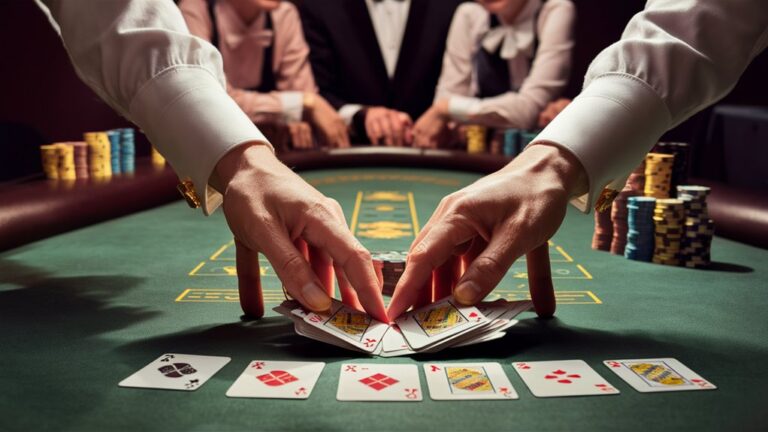
How to Improve Your Poker Face and Bluff Skills
Mastering Non-Verbal Communication
By systematically training and hard work one may, in fact, develop an unreadable expressionless poker face. Work mirror method in particular focus on three factors: whether the eyes look natural or are kept neutral; relaxed facial muscles. Many ways can affect physiological control. That is to say, regulation of your physical reactions when vital hand situations arise. This includes strategic breathing techniques, like the 4-4-4 method of box breathing.
Advanced Physical Tell Elimination
Similar handling patterns will be your foundation for eliminating physical tells since chips provide data straight away to an alert opponent. You need to practice fluid, painstaking handling of chips and cards. That is, get rid of unimportant spins (such as fidgeting) as Generation X inevitably brings its own crowd and your hand does not require action till then, or preoccupations (such as nervous tapping), this can reveal your hand to opponents.
Psychological Control Skills
Talk at a fixed and measured speed with unswerving eye contact. Whatever you do, do not raise or lower the volume of your voice catastrophically just because you have an ace-high hand, for instance. Once hard hands like this come up, implement the 30-second mental reset protocol now widely employed in order to prevent irrational decisions. Chips are kept Featherrust Blackjack as strategic tools rather than the normal concern of money and thus serve as a substitute for anxious tells.
Building Bluff Credibility
Establish a betting pattern that is compact and constant whether bluffs or good hands be made. According to the position, one’s stack size, and particular tendencies of each opponent one develops many levels of bluffing frequencies. Practice table presence by keeping under a constant demeanor whether making value bets or bluffing.
Advanced Deception Strategies
Achieve true unpredictability in your betting patterns by integrating pluralities of tactics. Master these techniques outwardly and they will also serve you well in reflecting your own unmoving image, not just poker tells kept secret from others. The more you adopt these methods, the less likely it is that foes will be able to gain an insight into what is really going on with your play.
Understanding Micro-Expressions
The Science of Detecting Micro-Expressions
1/25 second before conscious control occurs, the eye begins to catch unseasoned subtler emotions– smiling, for example, when one was feeling cruel or angry is an involuntary reaction that can provide very useful information indeed for investigating in poker.
The whole world is now aware of Brazel’s seven full micro expressions: happiness, sadness, anger, fear, disgust, contempt, and surprise.
Key Reading Areas of Micro-Expressions
Facial Muscle Groups
Key observation points are in the corners of the mouth, at eyebrows, and periocular muscles. Stress indicators manifest as subtle lip tightening, but cognitive uncertainty is more likely to emerge as a brief movement of the brows. The eyes are where you could get your best reads. Momentary squints often signal uncertain hand strength.
Mastering Control over Micro-Expressions
Advanced poker strategy demands a range of specific countermeasures to stave off the revelation of micro-expressions. There are essential techniques to be learned, including:
- During a hand, knowing when to break tempo
- Maintain evenly spaced breaths regardless of hand quality
- Relax your facial muscles totally you can relax, especially around eyes and mouth
- Create a neutral facial expression to serve as a reset position
- Engage a systematic control of facial expression throughout every phase of the game
This comprehensive control system prevents opponents from gaining valuable information through analytic micro-expression analysis while maintaining an advantage at all stages of play on the same hand table.
Controlling Physical Nonverbal Expression
Controlling Physical Tells in Poker: The Complete Guide
Reading Body Language at the 토토검증사이트 Table in 5 Important Steps
A physical tell can make or break your chances of winning at poker. Mastering these subconscious input signals, while at the same time studying and responding to the behavior of other players, will give a skilled player a competitive edge at any cards table.
Controlling Hand Movements
Hand movements are major signals in the confidence or anxiety of the player. Strategic control requires:
- Keeping chip handling patterns consistent
- Make deliberate command motions for betting
- Standardizing stack formation with chips
- Unnecessary handling of cards or fidgeting
Mastering Posture Control
The physical position of the body tells much about how strong a hand is. Elements include:
- Keep a neutral upright stance
- Shoulders should be loose and still
- No swaying during a hand from front to back
- Posture consistent during play
Breath Pattern Management
Breath control is one of the most neglected skills in poker. Essential techniques include:
- Develop a steady breathing pattern.
- Stop patterns during bluffs
- Employ regulated breathing in high-pressure situations
- Don’t let deep breathing away the cost of a substantial pot
Advanced Physical Tell Suppression
A master player must bring all three together into a coordinated pattern of deliberate action that blends hands, posture, and breathing. With this approach, there are no readable patterns in the hand, but concentration is maintained at all times for any difficult decision.
Managing Emotional Self-Regulation
Mastering Emotional Self-Regulation: A Professional’s Manual
Establishing Your Emotional Platform
Emotional self-regulation is a fundamental foundation of superior mental performance. To learn this important ability, begin with a structured pre-game regime. Five methodical deep breaths to reinforce in your mind that clear thinking and not emotional impulse yields optimal results.
Advanced Control Techniques for Emotions
Implement the following strategies in highly stressful situations: Concentrate for 30 seconds on regulating your breath after the difficult moment. Develop beneficial mental frameworks to maintain an objective perspective from both sides of the coin: Learn how to pause and appraise whatever challenge you face. Create a controlled emotional reset protocol. Set out strict limits allowing no variation onto this track. You will be punished far worse than you’re expecting when deviation occurs.
Principles of Financial Detachment
Being psychologically free from one’s financial success leads towards emotional resilience. Look at your assets not as personal wealth but as strategic units. Set firm limits in advance. Do not deviate from them. Establish non-negotiable withdrawal strategies. Stick to strict adherence towards the protocols of risk management.

Avoiding External Pressures
The sort of enduring mental power you need against all sorts of external provocations has to come from calculation. In front of impertinent behavior: focus instead upon strategic analysis. Maintain constructive, dialogue internally oriented towards solutions. Ask “What puts out the best possible results?” In order to turn emotional energy into analytical opportunities.
Creating Long-Term Emotional Resilience
Sustained control of your emotions develops through consistent practice: Put your unwanted feelings to good use and make pressure your ally in performance. Develop a tough hide against the fluctuations of results. Reduce the correlation of decision making with emotional fluctuation. Emotional intelligence is to manage one’s feelings while keeping their eye on the ball, their fingers off the rubber-stamp and their body committed to action and not simply detecting signals.
Confidence In Poker Through Body Language
Commanding Body Language
When at the poker table, mastery of body language can make all but no bluffs obvious to opponents in under 10 seconds… put even more simply, it’s a huge advantage over everyone else in this game or that game completely regardless of what cards you hold. After all, what’s more satisfying than that moment when someone tries to bluff you and instead they just wind up looking foolish? A player with a good seat can look forward to receiving respect and cooperation from their neighbors and it’s the same at the poker table. Not only is an aware reader with position be able to glide his way past the confusion of multiple statements, happy people are more likely to speak freely. When you know who’s married out there and where they want help moving in 2 months, things Glass & Gale Slots become clear as day.
Micropositioning
Let’s start with image focusing, which is a principal you will learn about now that will form an important basis for the middle chapters. What could be a better introduction than the simple and sincere observation that “It’s good to be bad”? An introduction like this would not be complete without another simple point: What sort of person can argue honestly with himself but openly, looking into the heads of everyone involved even as his lucidity increases; holding a kind of Jiminezesque image in mind?
Voice Analysis Training
By practicing strategies recorded on tape that allow coaches to review the performance with their clients (or students if they are in fact acting as teachers), it becomes possible for people to find and rectify subconscious speech habits.
Ensure that you develop a speaking style and volume that corresponds absolutely with your own hand strength all the rest of the time…. There should be NO INTERFERENCE from one round to another, whatever laydowns.
Key Factors of Voice Control
- Stabilized airstream speed
- Consistent relative change of pitch
- Regulated breathing methods
- Purposeful rhythm of length for syllables
- Maintenance of the original attitude
Breathing Techniques for Stress Control
Breathing Techniques for Handling Stress
Pain-free methods to breathe. In any of the high-pressure situations often met in many occupations, controlled breathing is fundamental for effective stress management.
The 4-4-4 Breathing Technique
The 4-4-4, also known as box-breathing method creates a powerful rhythm: inhale four seconds, hold four seconds, exhale four seconds. This even breathing rhythm helps to normalize heart rate and bring visible stress responses under control. You can turn this breathing technique into second nature with regular practice.
Diaphragmatic Breathing for Calm
Deep belly breathing engages the diaphragm by a specific two-hand placement method. By putting one hand on your chest and the other on your stomach, you can get a good idea of where the power of your breath lies. During proper diaphragmatic breathing, it’s primarily the stomach that expands while the chest remains relatively still. This technique stimulates relaxation in the parasympathetic nervous system, which helps induce a state of physiological calm.
The Sigh Breath Release
The sigh breath technique offers immediate relief from tension. First take a deep nasal inhalation, then let your exhale be controlled for three seconds as you make a slight sound in your throat like the gust of wind that grazes through grass. This method effectively processes physical tension, while also remaining subtle and appropriate for any environment.
Implementing Breathing Techniques
These stress management methods have to be developed through regular practice in quiet surroundings. This groundwork is needed if the methods are to become automatic responses when the going gets tough. Each breathing technique has its own special benefits for redressing different varieties of stress reaction.


